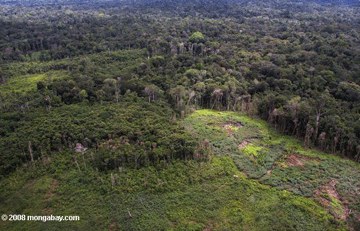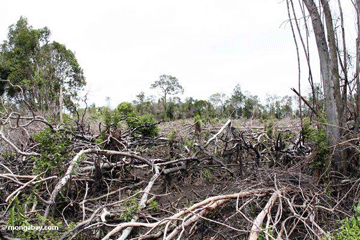Recovery of forests following the collapse of human populations in the Americas after the arrival of Europeans may have driven the period of global cooling from 1500-1750 known as the Little Ice Age, report researchers speaking at the annual meeting of the American Geophysical Union in San Francisco.
By some estimates, diseases introduced by Europeans may have killed more than 90 percent of population on the New World within a century of first contact. The rapid depopulation led to large-scale abandonment, and subsequent reforestation, of agricultural lands in the Americas. Analyzing charcoal found in soils and lake sediments at sites across the Americas, Richard Nevle and Dennis Bird found evidence to suggest that this forest regeneration sequestered enough carbon to trigger global cooling.
“We estimate that the amount of carbon sequestered in the growing forests was about 10 to 50 percent of the total carbon that would have needed to come out of the atmosphere and oceans at that time to account for the observed changes in carbon dioxide concentrations,” said Nevle, a visiting scholar in the Department of Geological and Environmental Sciences at Stanford.

|
The researchers focused specifically on changes in charcoal deposits at their study sites. Charcoal deposits were on the rise, indicating increasing conversion of forest for cropland, until 500 years ago when they showed an abrupt drop, coinciding with the human population crash in the Americas. The researchers compared the timing with the climate record and found a close correlation.
“We looked at ice cores and tropical sponge records, which give us reliable proxies for the carbon isotope composition of atmospheric carbon dioxide. And it jumped out at us right away,” Nevle said. “We saw a conspicuous increase in the isotope ratio of heavy carbon to light carbon. That gave us a sense that maybe we were looking at the right thing, because that is exactly what you would expect from reforestation.”
Due to the tendency of plants to use the lighter form of carbon during photosynthesis, the change in the ratio of heavy carbon to light carbon in the atmosphere reflects a massive increase in global plant growth.
The researchers say their data lines up better with the historic climate record than other theories proposed to explain the Little Ice Age, including changes in sunlight and an increase in volcanic activity in the late 16th century.
“The timing of these events doesn’t fit with the observed onset of the carbon dioxide drop,” wrote Louis Bergeron in a statement released by Stanford. “These events don’t begin until at least a century after carbon dioxide in the atmosphere began to decline and the ratio of heavy to light carbon isotopes in atmospheric carbon dioxide begins to increase.”
Nevle says that while these factors may have influenced climate, “reforestation is certainly a first-order contributor.”
Related
Indigenous populations deforested New World rainforests before European contact
February 28, 2007
Indigenous populations used fire to clear large areas of tropical forest well before the arrival of Europeans reports a new study published in Annals of the Missouri Botanical Garden. The research has important implications for understanding the impact of present forest development on biodiversity and forest regeneration in the tropics. Using pollen, phytolith, and charcoal records to identify the distribution and composition of tropical vegetation and fire patterns over the past 11,000 years, Dolores R. Piperno of the Smithsonian Tropical Research Institute in Panama and National Museum of Natural History in Washington, DC, found evidence of widespread fire use for land-clearing by pre-Colombian populations in Latin America. Her work confirms earlier research suggesting the substantial impact native populations had on tropical forests long before European arrival in the New World.
Humans impacted climate thousands of years ago September 9, 2005
New research suggests humans were influencing the world’s climate long before the Industrial Revolution. Atmospheric levels of methane, a potent greenhouse gas, climbed steadily during the first millennium due to massive fires set by humans clearing land for agriculture. The research, published in this week’s Science, is detailed below.
